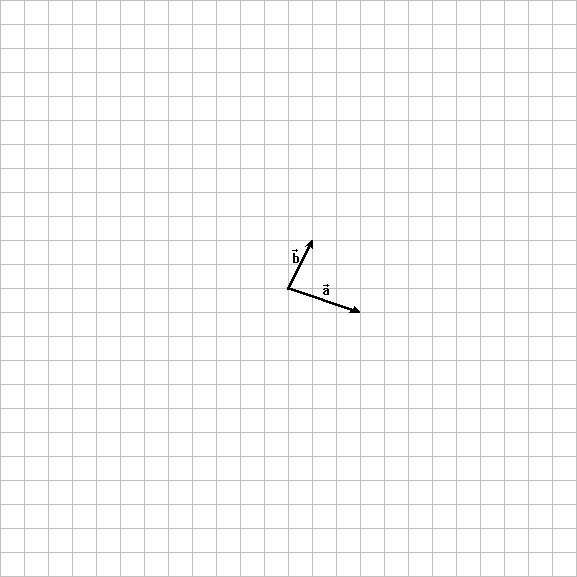ACTIVITIES ABOUT VECTORS IN THE PLANE
User manual
INDEX
1.- DESCRIPTION AND REQUESTS OF THE APPLICATION
This application consists in five didactic units with the aim of:
· Work with given vectors graphically (arrows)
· Work with vectors using coordinates and components
· Work with modules and arguments of vectors (vectors in a polar form)
· Apply vectors to solve problems of plane geometry
· Introduce in the scalar product of two vectors and make some applications about them
· PLATFORM, OPERATIVE SYSTEM AND NAVIGATOR
This pack of programs is a multiplatform application (Windows, Mac OS X, Linux), it can function on line and in local. Try to a group of HTML pages that they have to be visualized with a navigator that carries out with the main Internet standards (Mozilla Firefox, IExplorer...). The interactive activities include an applet Java, for this reason it's necessary to have the JAVA virtual machine installed and activated.
· APPLETS CINDERELLA
The interactive applets Java have been done with an interactive Software of geometry Cinderella. When you start it, you shall be patient because the loading of the first activity is generally slow; It can take time some minutes depending of the transference speed from de server. Once the activity has loaded, next activities will load easier that this, and they will not take long, only few seconds.
· MOUSE
To carry out the interactive activities it is essential to have a mouse to work correctly. All interactive activities demand to push with left button of mouse some points of the plane, and to scroll them maintaining the pushed button. Any problem with mouse, like dirt, bad configuration , etc., will complicate the execution of these activities, to get the desired results or to work with the desirable precision.
They propose 50 activities grouped in five didactic units. The titles, both of the units and of the each activity, are explicit according to the aim of each of them:
DIDACTIC UNIT 1: Work with given vectors graphically (arrows)
Activity 1.1 Vectors: module, direction and way
Activity 1.2 Sum of vectors
Activity 1.3 Commutativity of sum. Parallelogram law
Activity 1.4 Associativity of sum
Activity 1.5 Commutativity of sum of three or more vectors
Activity 1.6 Sums and subtractions of vectors
Activity 1.7 A scalar product by a vector
Activity 1.8 Linear combinations of two vectors
Activity 1.9 Linear combination of three vectors
Activity 1.10 Distributivity of the product with respect to the sum
DIDACTIC UNIT 2: Work with vectors using coordinates and components
Activity 2.1 Components of a vector
Activity 2.2 Sum of vectors using components
Activity 2.3 Parallelogram law
Activity 2.4 Associativity of sum
Activity 2.5 Commutativity of sum
Activity 2.6 Sums and subtractions of vectors
Activity 2.7 Vectors and translations
Activity 2.8 Vectors and forces. An example: a boat in a channel
Activity 2.9 Products by scalars and linear combination
Activity 2.10 More about linear combinations
DIDACTIC UNIT 3: Modules and arguments. Vectors in a polar way.
Activity 3.1 Module of a vector
Activity 3.2 Argument of a vector
Activity 3.3 Vectors in polar form (or like module-argument)
Activity 3.4 Module of the product of scalar one by a vector
Activity 3.5 Argument of the product of a scalar one by a vector
Activity 3.6 Module of two vectors sum
Activity 3.7 Obtaining of vectors of module 1 (united)
Activity 3.8 Obtaining of them components known the module and the argument
Activity 3.9 Obtaining of the module and of the argument known them components
Activity 3.10 Two given vectors in polar form
DIDACTIC UNIT 4: Firs applications of vectors to the geometry
Activity 4.1 Midpoint of a segment
Activity 4.2 Symmetrical of a point with respect to another point
Activity 4.3 Division of a segment in more than two parts
Activity 4.4 Barycentre of a triangle
Activity 4.5 Parallelism of vectors
Activity 4.6 Alignment of points
Activity 4.7 About parallelograms
Activity 4.8 Introduction to the bases: canonical bases
Activity 4.9 Bases not canonical
Activity 4.10 Bases not canonical neither oblique
DIDACTIC UNIT 5: Scalar product of two vectors
Activity 5.1 Definition of scalar product of two vectors
Activity 5.2 Geometrical interpretation of the scalar product
Activity 5.3 Properties: commutativitat and associativity with respect to scalars
Activity 5.4 Properties: distributivitat respect to the sum
Activity 5.5 Obtaining the scalar product from the components
Activity 5.6 Perpendicularity of two vectors
Activity 5.7 Cosine the angle that forms two vectors
Activity 5.8 Projection of a vector on another
Activity 5.9 We find again the theorem attribute to Thales of Miletus
Activity 5.10 We find again the theorem of Pythagoras
Each activity consists in three parts:
a) A little explanation
In this explanation we introduce concepts and also we explain fixed procedures (on a short way). Each explanation goes with a figure what illustrates introduced concepts and explained procedures. Student shall read with attention these explanations.
b) An interactive activity
These interactive activities include an applet done with interactive software of geometry Cinderella. Generally, the execution of the activity demands to push left button of mouse on some points (green points), to move them maintain pushed the button to get some results.
All the interactive activities are accompany of an hyperlinked that they give correct solution.
We remember again that to execute these interactive activities that we propose it's essential to have a mouse which works correctly and any problem with mouse, dirty, bad configuration, etc., will complicate the execution of these activities, to get the wished result or to work with the desirable precision.
Respect to precision of the result, you have to run away of the excessive perfectionism. For instance, if we check a specific property, and the student doesn't get right when he puts the point in the uncorrect place, but he makes a construction that in a approximate way shows that the property is verified, we take for granted that the check is made.
c) Homework
Homework are works to consolidate acquired concepts/procedures in the activity and the student will have to make it in his notebook. It is provided that student will work with coordinates and components, it is convenient that it will be a notebook with squared paper.
To make the execution of these activities will be necessary basic tools to draw, as: graduated ruler, compass, set square, protractor of angles, ... Also it will be necessary to make use a scientific calculator (with trigonometric functions and trigonometric inverses) for units 3 and 5(module-argument and scalar product).
There is a possibility to get Word documents specially to make homework. In homework appears an hyperlink which gives a document and the student can print it.
1.- A, B, C and D are arbitrary points of the plane. Simplify next expressions giving the result in a form ![]() (that is to say, giving the origin and extreme of the result):
(that is to say, giving the origin and extreme of the result):
|
|
|
|
|
|
|
2.- Make a geometrical construction that it manifests the commutativity of the three vectors sum.
3.- From given vectors ![]() and
and ![]() of the figure, draw next vectors:
of the figure, draw next vectors:
|
4.- If vector ![]() has the module 4 (that is to say,
has the module 4 (that is to say, ![]() ) calculate module of next vectors:
) calculate module of next vectors:
Module of 3
:
Module of -4
:
Module of ¾
:
Module of -0.5
:
Module of ½
:
5.- Next figure is a parallelogram,  and
and ![]()
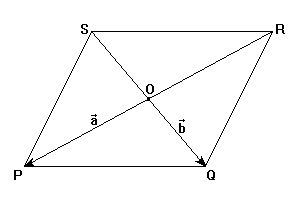
a) Express next vectors depending of
and of
:
,
,
and
.
b) Calculate the two different ways of the sum vector
.
6.- Given the regular octagon of the figure
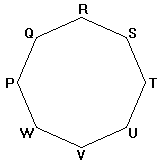
a) Draw vector

b) Try to put previous vector in the way
(that is to say, one scalar by a vector).
7.- If ![]() =(4,-2),
=(4,-2), ![]() =(-1,5) and
=(-1,5) and ![]() =(0,3), calculate:
=(0,3), calculate:
8.- From the given triangle of vertexes A(4,2), B(10,5) and C(2,6), is demanded:
a) Calculate

b) What is the perimeter of the ABC triangle?
c) Is ABC a rectangle triangle ? Justify the answer.
9.- Write vector![]() = (-2,7) like a linear combination of two vectors
= (-2,7) like a linear combination of two vectors![]() = (2,-1) and
= (2,-1) and ![]() = (2,2).
= (2,2).
10.- Where are located the extremes of all the vectors that they have module 4 if its origin is the coordinates origin? Draw some vectors of module 4 (with its origin in the coordinates origin) in this graphic. |
|
11.- Where are located the extremes of all the vectors that they have argument 60º if its origin is the coordinates origin? Draw some vectors of argument 60º (with its origin in the coordinates origin) in this graphic. |
|
12.- If | |
|
13.- Draw approximately next four vectors: 545º, 3120º, 6210º and 4-20º. Calculate later his components. |
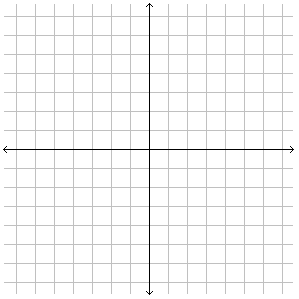 |
14.- Calculate the module and the argument of vectors ![]() ,
, ![]() and
and ![]() knowing that A(3,2), B(-1,-1) and C(3,-1). Later you put vectors
knowing that A(3,2), B(-1,-1) and C(3,-1). Later you put vectors ![]() ,
, ![]() and
and ![]() in polar form.
in polar form.
15.- We walk in straight line 3 km to E direction, later 4 km to NE direction and finally, 8 km to S direction.
|
|
b) Calculate how many km we are far from the beginning.
16.- In the next table you have different given vectors in two ways. Complete the gaps in the table.
Form: in components |
Form: polar |
(5,3) |
|
(40,-30) |
|
5270° |
|
5.656945° |
|
(0, 6) |
|
(0,-1) |
|
4120° |
|
(-12,5) |
|
1180° |
17.- If ![]() and
and ![]() , calculate a vector
, calculate a vector ![]() which verifies
which verifies ![]() . You give us the result in polar form.
. You give us the result in polar form.
18.- From given points A(4,2), B(10,5), C(2,6) and D(x,9),it is demanded:
a) Calculate coordinates of the midpoint of the BC segment .
b) Calculate coordinates of the symmetrical point of B with respect to A.
c) Calculate x because points B, C and D being aligned.
d) Calculate x because
and
being parallel.
e) Calculate x because
and
have the same module.
19.- In the next table you have different given vectors in three ways. Complete the gaps in the table.
Form: in components |
Form: according to |
Form: polar |
(-2,5) |
||
6 |
||
5270° |
||
1030° |
||
-4 |
||
(0,-1) |
||
5135° |
||
6 |
||
(3,5) |
||
1270° |
||
5(cos60º |
20.- From given vectors ![]() = (a,5) and
= (a,5) and ![]() = (8,4), calculate a because:
= (8,4), calculate a because:
a) being parallel.
b) being perpendiculars.
c) verify that
·
= 42 .
21.- From given vectors ![]() =(6,8) and
=(6,8) and ![]() =(-5,12) , calculate:
=(-5,12) , calculate:
a) (2
+
)·(2
-
) .
b) (
+
)2 .
c) The angle formed by the vectors
and
.
22.- If ABCD is a parallelogram
|
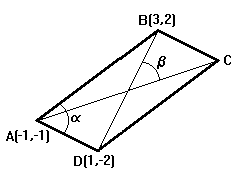 |
| 23.- Calculate scalar product of vectors |
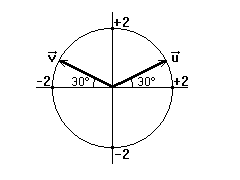 |
24.- From given points A(2,6), B(4,8), C(3,2) and D(7,1), it is demanded:
a) Calculate angle that forms vectors
and
.
b) Calculate angle that forms vectors
+
and
-
.
